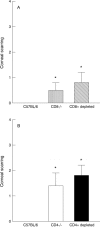Both CD4+ and CD8+ T cells are involved in protection against HSV-1 induced corneal scarring
- PMID: 10729300
- PMCID: PMC1723442
- DOI: 10.1136/bjo.84.4.408
Both CD4+ and CD8+ T cells are involved in protection against HSV-1 induced corneal scarring
Abstract
Aim: To determine the relative impact of CD4+ T cells and CD8+ T cells in protecting mice against ocular HSV-1 challenge.
Methods: CD4+ T cell knockout mice (CD4-/- mice), CD8+ T cell knockout mice (CD8-/- mice), and mice depleted for CD4+ or CD8+ T cells by antibody (CD4+ depleted and CD8+ depleted mice), were examined for their ability to withstand HSV-1 ocular challenge. The parental mice for both knockout mice were C57BL/6J.
Results: These results suggest that: (1) both CD4+ deficient mice (CD4-/- and CD4+ depleted mice) and CD8+ deficient mice (CD8-/-, and CD8+ depleted mice) developed significantly more corneal scarring than their C57BL/6J parental strain; (2) the duration of virus clearance from the eyes of the CD4+ deficient mice was 4 days longer than that of the CD8+ deficient mice; and (3) the severity of corneal scarring in the CD4+ deficient mice was approximately twice that of the CD8+ deficient mice.
Conclusions: It was reported here that: (1) CD4+ and CD8+ T cells were both involved in protection against lethal ocular HSV-1 infection; and (2) CD4+ and CD8+ T cells were both involved in protection against HSV-1 induced corneal scarring.
Figures



References
Publication types
MeSH terms
Grants and funding
LinkOut - more resources
Full Text Sources
Research Materials
